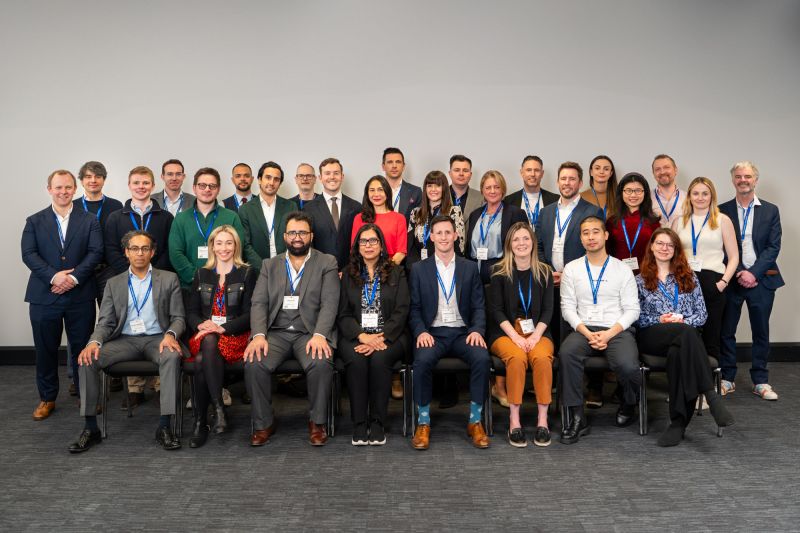Across England we’re supporting local systems to implement Artificial Intelligence (AI) solutions that are improving productivity and efficiency – whether that’s through releasing clinician time, improving patient care or reducing waiting lists.
We asked our Clinical Directors from across the Network to share their insights into what they believe the opportunities and risks of AI are.
Our experts are: Natasha Curran is Medical Director at the Health Innovation Network South London, Joint Director of Clinical Strategy at Kings Health Partners & Consultant in Pain Medicine & Anaesthesia at University College London Hospitals, Keith Gomes-Pinto is Strategic Clinical Advisor at Health Innovation Wessex and Chief Medical Information Officer at NHS Dorset, David Aldulaimi is Clinical Director at South Warwickshire University NHS Foundation Trust (SWFT), and is a board member at Health Innovation West Midlands and Jag Ahluwalia is Chief Clinical Officer at Health Innovation East.
What potential does AI have to improve productivity for local trusts?

Natasha Curran
Natasha: “What excites me about AI is getting rid of the unnecessary and duplicative tasks in order to free up clinician time with the patient. I would love to have a consultation where I could focus completely on the conversation, have all relevant information accurately and concisely recorded in the ‘notes’, plus a warm, accurate letter ready at the end to give to the patient!”
Keith: “AI and robotics have huge potential and if properly implemented can extend human capabilities and enable us to focus on elements of care where we add more value, especially in an environment where the NHS is under immense pressure.”

Jag Ahluwalia
David: “The potential uses to AI include; training models to support services with capacity issues, such as pathology and radiology, to stratify and automate processes, to develop large language models that can support with routine administrative responsibilities, such as the dictation of letters, and to support the training of clinicians.”
Jag: “I am really very positive about the very broad potential for AI in healthcare. Perhaps the most immediate benefits lie within, or are already in use, where AI is deployed in image analysis, triage and decision support for example in radiology, pathology, ophthalmology, dermatology – often where clinicians are in short supply.”
What risks should trusts be considering?

Keith Gomes-Pinto
Jag: “It seems to me that the risks of AI (and clearly these exist and need addressing) need to be balanced against the already present risks of demand for healthcare outstripping capacity to deliver this.
“The opportunity to create time for humans to focus on the stuff that only we can do in healthcare must be a key objective of AI usage and given the global shortage of healthcare workers, between 10 and 18 million by 2030 (1) (2), AI must be actively embraced as a key resource rather than resisted.”
Keith: “Regarding concerns that AI will replace the workforce, studies have highlighted that jobs requiring critical thinking are unlikely to be impacted. Admittedly, we need to start considering role evolution, which should be an active process, as the adoption and scaling of AI ramps up, especially with nationally driven initiatives.”
What advice would you give to clinicians looking to adopt AI technologies?
Natasha: “My advice to clinicians would be to get involved, learn and be part of the solution!”

David Aldulaimi
David: “I’d recommend looking at the organisation’s Digital Strategy, the NHS Transformation strategy, then speaking with a member of their organisation’s IT team.”
Jag: “In terms of advice for those looking to adopt AI into their practices, I would always recommend clinicians ask – what was the training data set used to develop the AI algorithms, how diverse, inclusive and representative of the population that I look after was the training data? Where are the gaps in the training data? If these questions are not answerable or worse, have not even been thought about, I too would indeed be wary.”
If you’d like support to implement an AI solution or if you want to find out how technology could meet an unmet need in your area, contact your local health innovation network.
You can read more about some of the AI technologies we are supporting across the Network are improving patient experience here.
References
- World Health Organization. (2016). Global strategy on human resources for health: Workforce 2023. [Online]. www.iris.who.int. Last Updated: 2016. Available here. [Accessed 22 July 2024].
- Boniol, M. et al. (2022). The global health workforce stock and distribution in 2020 and 2030: a threat to equity and ‘universal’ health cover. BMJ Global Health. 7(7). [Online]. Available here. [Accessed 29 July 2024].

The need for fast-paced innovation in healthcare is widely acknowledged. And ensuring that healthcare innovation is shaped by the people it serves remains a pressing priority – one made all the more evident by the growing emphasis on health equity in the 10 Year Health Plan. Patient voices are often cited as central to healthcare [...]

The NHS Innovation Accelerator (NIA) has revealed its 2025 cohort of Fellows. As the NIA celebrates a decade of helping to drive innovation in the NHS, this year’s cohort aligns with the Government’s three priorities: supporting the transition from analogue to digital, sickness to prevention and hospital to home. The 28 new Fellows will benefit [...]

A new guide aimed at helping primary care organisations and integrated care boards understand and address problematic polypharmacy has been launched by the Health Innovation Network as part of its national Polypharmacy Programme. Developed in response to a clear need identified by primary care and prescribing colleagues, this essential resource provides practical, evidence-based strategies to [...]









